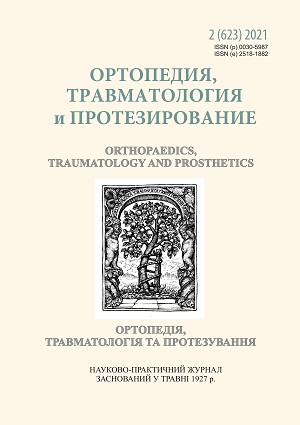Остеосинтез у разі переломів шийки та вертлюгової зони стегнової кістки в дітей
DOI:
https://doi.org/10.15674/0030-59872021210-16Keywords:
Children, fracture, proximal femur, treatment, device for ostheosynthesisAbstract
Proximal femur fractures are uncommon injuries in children, accounting for less than 1 % of all fractures per year, but usually result in hospitalization and are at risk of complications. We have designed a device for bone fragments fixation in the case of proximal femur fractures and the method of its application in adults. The device consists of rods that are screwed into the cap of the head, the diaphyseal part and the module, which is located in the subtrochanter area. The rods can be connected to the module at any angle in the frontal plane. The device provides a certain stage of installation of the elements, which allows you to effectively place it with minimal bone destruction. Objective. Share your own experience in the treatment of femoral neck and proximal femur fractures in children. Material. The experience of treatment of 28 children with femoral neck fracture or proximal femur fractures for the period 2005–2020 is presented, 11 of them were treated conservatively with the skeletal traction. Osteosynthesis by the author’s device was performed in 17 patients: 15 closed reduction, 2 in case of intertrochanteric fracture, — open reduction. The method of osteosynthesis and postoperative management of patients is described in detail. Results. In children who were treated conservatively, the fracture consolidation was achieved within 5–7 months, in one of them — in the position of varus deformity. In contrast to conservative treatment, children began to walk with crutches after a few days after surgery, with partial weight-bearing on injured limb. The device was removed in 16 patients after 5–8 months, and complete fracture consolidation of the fragments in their anatomical position was noted. There were no pathological tissue reactions to the metal device. Conclusions. The proposed device and method of closed osteosynthesis with its usage in the case of proximal femur and femoral neck fractures in children can be recommended in the practice of pediatric traumatology.
References
- Patterson, J. T., Tangtiphaiboontana, J., & Pandya, N. K. (2018). Management of pediatric femoral neck fracture. Journal of the American Academy of Orthopaedic Surgeons, 26(12), 411-419. https://doi.org/10.5435/jaaos-d-16-00362
- Pinto, D. A., & Aroojis, A. (2020). Fractures of the proximal femur in childhood: A review. Indian Journal of Orthopaedics, 55(1), 23-34. https://doi.org/10.1007/s43465-020-00259-4
- Korzh, A. A., & Bondarenko, N. S. (1994). Injury to bones and joints in children. Kharkiv: Prapor. (in Russian)
- Beaty, J. H., & Kasser, J. R. (2009). Rockwood and Wilkins’ Fractures in Children. 7th ed. Philadelphia : Lippincott, Williams & Wilkins
- Bali, K., Sudesh, P., Patel, S., Kumar, V., Saini, U., & Dhillon, M. S. (2011). Pediatric femoral neck fractures: Our 10 years of experience. Clinics in Orthopedic Surgery, 3(4), 302. https://doi.org/10.4055/cios.2011.3.4.302
- Boardman, M. J., Herman, M. J., Buck, B., & Pizzutillo, P. D. (2009). Hip fractures in children. Journal of the American Academy of Orthopaedic Surgeons, 17(3), 162-173. https://doi.org/10.5435/00124635-200903000-00005
- Medda, S., Snoap, T., & Carroll, E. A. (2019). Treatment of young femoral neck fractures. Journal of Orthopaedic Trauma, 33(1), S1-S6. https://doi.org/10.1097/bot.0000000000001369
- Bukva, B., Abramović, D., Vrgoč, G., Marinović, M., Bakota, B., Dučić, S., Miškulin, M., Brdar, R., Čoklo, M., & Gulan, G. (2015). Femoral neck fractures in children and the role of early hip decompression in final outcome. Injury, 46, S44-S47. https://doi.org/10.1016/j.injury.2015.10.059
- Popsuyshapka, O. K., & Pobel, E. A. (2006). Device for the treatment of fractures of the neck and acetabulum of the femur. Ukraine. Patent 13777 UA. (in Ukrainian)
- Certificate of state registration 10276/211 Device rod for the connection of bone fragments in the treatment of fractures of the extremities TU.U 33.1-35700506-001: 2011. According to the order of the State Medical Inspectorate of the Ministry of Health of Ukraine dated 15.03.2011. (in Ukrainian)
- Popsuyshapka, A. K., Pobel, E. A., & Manankov, O. N. (2006). Stresses in the structure "fragments-fixator" about osteosynthesis of fractures of the femoral neck by various devices. Orthopedics, Traumatology and Prosthetics, 2, 42–48. [in Russian]
- Popsuyshapka, A. K., Pobel, E. A., Shevtsova, M. A., & Belogurova, L. S. (2006). Study and evaluation of the biomechanical structure "fragments-fixator" created for the surgical treatment of fractures of the femoral neck. Orthopedics, traumatology and prosthetics, 4, 55–62. [in Russian]
Downloads
How to Cite
Issue
Section
License

This work is licensed under a Creative Commons Attribution 4.0 International License.
The authors retain the right of authorship of their manuscript and pass the journal the right of the first publication of this article, which automatically become available from the date of publication under the terms of Creative Commons Attribution License, which allows others to freely distribute the published manuscript with mandatory linking to authors of the original research and the first publication of this one in this journal.
Authors have the right to enter into a separate supplemental agreement on the additional non-exclusive distribution of manuscript in the form in which it was published by the journal (i.e. to put work in electronic storage of an institution or publish as a part of the book) while maintaining the reference to the first publication of the manuscript in this journal.
The editorial policy of the journal allows authors and encourages manuscript accommodation online (i.e. in storage of an institution or on the personal websites) as before submission of the manuscript to the editorial office, and during its editorial processing because it contributes to productive scientific discussion and positively affects the efficiency and dynamics of the published manuscript citation (see The Effect of Open Access).














